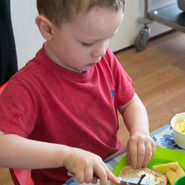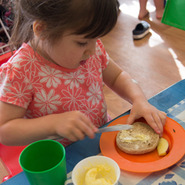says Snapdragons' Mary Llewellin.

The food we eat is as likely to be affected by fashion as the clothes we wear, but the difference is our fashion failures only damage our pride whereas our nutritional choices affect our health. Take, for example, the biggest food trend in recent history: convenience foods. These highly processed ready meals saved time for busy families but brought with them high salt, fat and sugar levels as well as a whole science lab full of artificial additives like monosodium glutamate and E-numbers.
 Snacking throughout the day on biscuits, cakes and crisps has become routine for many people because of the ease with which we can consume them. The legacy of this moment in food fashion is well documented and includes obesity, cancer, heart disease, behavioural issues and the loss of mealtimes as a social occasion both during the preparation and eating of our food. In a bid to turn the tide, successive governments have invested in healthy eating initiatives and the focus has increasingly fallen on us, the education sector, to guide the next generation to better health.
Snacking throughout the day on biscuits, cakes and crisps has become routine for many people because of the ease with which we can consume them. The legacy of this moment in food fashion is well documented and includes obesity, cancer, heart disease, behavioural issues and the loss of mealtimes as a social occasion both during the preparation and eating of our food. In a bid to turn the tide, successive governments have invested in healthy eating initiatives and the focus has increasingly fallen on us, the education sector, to guide the next generation to better health.
The statutory framework for the Early Years Foundation Stage states: 'Where children are provided with meals, snacks and drinks, they must be healthy, balanced and nutritious.' But which of the healthy-eating messages should we be listening to? For years we have heard that a healthy diet is high in fibre and low in fat, but these guidelines are not appropriate for very young children, who need good fats to support growth and can't cope with too much fibre.
Recognising the need for consistent nutritional advice for early years, in 2010, the Government asked the Children's Food Trust to look at the existing guidance available for childcare providers. It formed the Advisory Panel on Food and Nutrition in Early Years,which found clear demand for a recognised, national source of practical guidance for providers.
The Voluntary Food and Drink Guidelines for Early Years Settings in England was the result, and we now have a clear and practical resource which, along with our Food for Life Gold Catering Mark from the Soil Association and our own Healthy Eating Policy, has formed the basis of our food provision at Snapdragons.
What is so important about snacks?
Children under five are developing very fast, so they have high energy and nutrient requirements in relation to their size. Their little stomachs can't process big meals so it is important that they should eat little and often but that their between-meal snacks should be just as nutritious as their main meals and follow the same general rules. At Snapdragons, we provide mid-morning and afternoon snacks that contain a balance of starch, fruit and vegetables, protein and dairy foods. The snacks are planned across the week's menu to ensure that each day's food is balanced and each snack is intended to provide 10 per cent of the children's daily nutritional intake.
Help yourself
 As with main meals, snacktime brings with it some great opportunities for developing children's self-help skills and preparing them for school. Our children help themselves to the different snack elements from serving plates and we encourage them to be as self-sufficient as possible while supporting their choices. They can help to prepare their own snacks by cutting fruit, vegetables and bread into manageable pieces, spreading their own toppings and pouring their own milk or water. They are also asked to help the grown-ups by clearing their own plates away.
As with main meals, snacktime brings with it some great opportunities for developing children's self-help skills and preparing them for school. Our children help themselves to the different snack elements from serving plates and we encourage them to be as self-sufficient as possible while supporting their choices. They can help to prepare their own snacks by cutting fruit, vegetables and bread into manageable pieces, spreading their own toppings and pouring their own milk or water. They are also asked to help the grown-ups by clearing their own plates away.
What is on the menu?
A typical snack at Snapdragons would be a 30g slice of our chef Raquel's homemade vegetable bread with 4g of cream cheese, 40g of sliced apple and water to drink. We don't actually weigh these out at the table, of course, but you begin to be able to judge the portion sizes by eye quite quickly. This is where adult guidance is vital during self-serve snacktimes.
Dips are great for introducing new flavours and textures, as well as small amounts of protein, to snacks. Raquel makes different houmous, for example, or sometimes blends some cooked fish with creme fraiche or cream cheese to make a pate to serve with vegetable sticks or pitta bread.
Sweet enough
We don't serve biscuits, cakes, dried fruit or fruit juice at snacktime because of the damage they cause to children's teeth. When children are eating little and often this means that their teeth are under regular attack so keeping the sugar content down is vital.
The other downside of sugary snacks is that they are full of empty calories, which give quick-release energy with very low nutritional benefits. The intrinsic sugars found in fruit and vegetables are a much more healthy option because they break down more slowly, releasing energy more consistently and avoiding the swings in energy and mood.
Food fashions come and go, but if you cook as much as possible from scratch using fresh, seasonal ingredients and the many great resources now available you should avoid too many food fashion faux pas.
A SNAPDRAGONS FAVOURITE
Try making our Seasonal Fruity Pancakes, a favourite Snapdragons snack.
Ingredients
Makes 20
250g self-raising flour
½ level tsp baking powder
2 medium eggs
270ml whole milk
50g unsalted butter, melted
150g fresh seasonal fruit such as grated apple or pear, diced banana, whole reaspberries.
Oil for frying
Ingredients- 250g self-raising flour
- 1/2 level tsp baking powder
- 2 medium eggs
- 270ml whole milk
- 50g unsalted butter, melted
- 150g fresh seasonal fruit such as grated apple or pear, diced banana
or whole raspberries
- Oil for frying
]]









